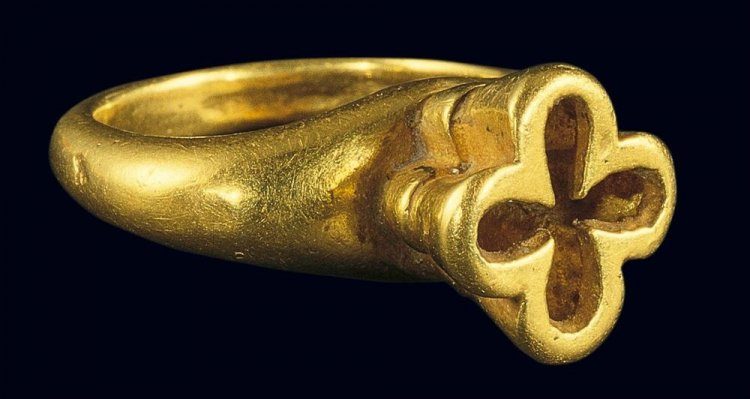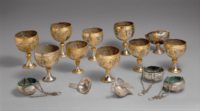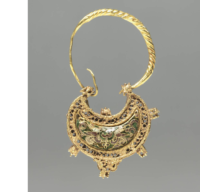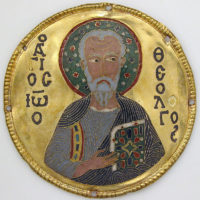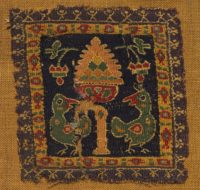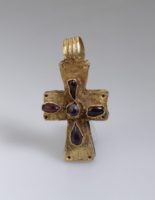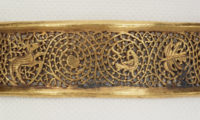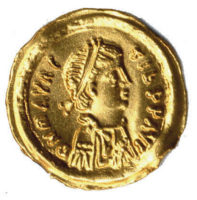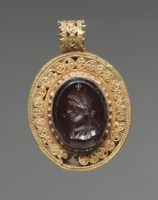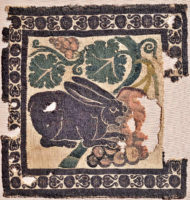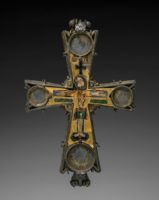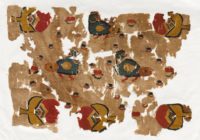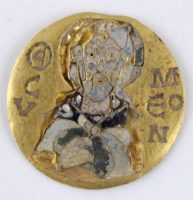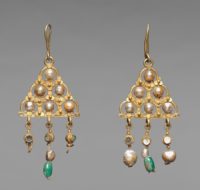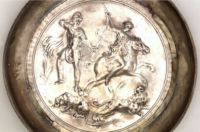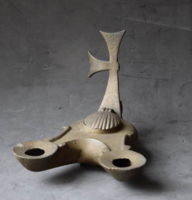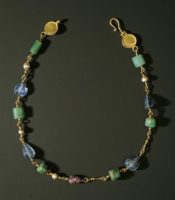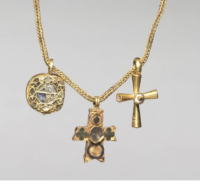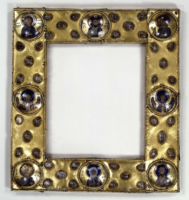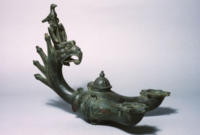Ring with cross-shaped quatrefoil calyx bezel. Materials: gold. Period: Early Byzantine; circa: 6th-7th century. The Benaki Museum of Greek Culture is housed in one of the most beautiful neoclassical-style buildings in Athens, near the National Garden and the Hellenic Parliament.
The Attarouthi Treasure, Period: Early Byzantine, circa: 500-650s. Made in Attarouthi, Syria. Materials: Silver, silver-gilt. On view at The Met Fifth Avenue in Gallery 300.
These well-wrought liturgical items– chalices, censers, a filter, and also a depiction of the dove of the Holy Spirit– were amongst the belongings of a Christian church in the wealthy seller city of Attarouthi in Syria, after that among the wealthiest lands of the Byzantine Empire. The chalices, censers, and also filter were made use of for the Divine Liturgy, or Eucharist, where Christians take consecrated wine and bread in ceremony of the Last Supper and also Christ’s death. According to their inscriptions, written in Greek with several spelling variants, many of the objects were offerings of local citizens to the major church of the town, which was dedicated to Saint Stephen, and to a smaller church dedicated to Saint John (probably Saint John the Forerunner [the Baptist]). In the very early 7th century Syria dropped initially to the Sasanian Persians and afterwards to the militaries of Islam. These works were most likely hidden in haste in a safety container at some minute when the Byzantine military was pulling away from strikes on the area.
The Metropolitan Museum of Art (New York) is one of the world’s largest and finest art museums. Its collection includes more than two million works of art spanning five thousand years of world culture, from prehistory to the present and from every part of the globe. Public Hours: 10:30 a.m.–5:30 p.m. Open seven days a week.
[xyz-ihs snippet="Met-Museum-Booking"]Crescent-Shaped Earring, Materials: Gold filigree with cloisonné enamel. Period: Middle Byzantine circa: 1000-1100. Dimensions: 2.3 x 2.6 cm (7/8 x 1 in.). The Cleveland Art Museum Hours: Tuesdays, Thursdays, Saturdays, Sundays 10:00 a.m.–5:00 p.m. Wednesdays, Fridays 10:00 a.m.–9:00 p.m. Closed Mondays.
Medallion with Saint John the Evangelist from an Icon Frame, Period: Middle Byzantine, circa: 1100, Made in Constantinople, Materials: Gold, silver, and enamel worked in cloisonné. On view at The Met Fifth Avenue in Gallery 303. The Metropolitan Museum of Art (New York) is one of the world’s largest and finest art museums. Its collection includes more than two million works of art spanning five thousand years of world culture, from prehistory to the present and from every part of the globe. Public Hours: 10:30 a.m.–5:30 p.m. Open seven days a week.
Square Segmentum with Two Birds, Period: Early Byzantine; circa: 400s – 500s; Made in: Egypt, Material: tapestry; linen and wool. Dimensions: Overall: 10 x 10 cm (3 7/8 x 3 7/8 in.). The Cleveland Art Museum Hours: Tuesdays, Thursdays, Saturdays, Sundays 10:00 a.m.–5:00 p.m. Wednesdays, Fridays 10:00 a.m.–9:00 p.m. Closed Mondays.
Cross, Period: Early Byzantine, circa: 5th-6th century, Materials: golad and garnet. Dimensions: 3,8×1,9 cm. The collection of the State Hermitage includes over 3 million works of art and world culture artefacts. It contains paintings, graphic works, sculptures, works of applied art, archaeological artefacts and numismatic objects. The Hermitage is considered to have been founded in 1764, when Empress Catherine the Great acquired an impressive collection of works from the Berlin merchant Johann Ernst Gotzkowsky. The museum celebrates the anniversary of its founding each year on 7 December, St. Catherine’s Day. Opening Hours: Tuesday, Thursday, Saturday, Sunday: 10.30-18.00 Wednesday, Friday: 10.30-21.00 Closed: Monday.
Bracelet, Period: Late Roman circa: 379 – 395 A.D. Medium: Gold. Dimensions: 1.4 × 6.3 cm (9/16 × 2 1/2 in.) Museum Description: “A simple gold band with plain flanged edges forms this openwork bracelet. A vegetal scroll weaves across the surface of the band, into which hunting scenes are inserted. On one side a hound chases a stag, while on the other a hound pursues a hare. ”
The J. Paul Getty Museum at the Getty Center in Los Angeles houses European paintings, drawings, sculpture, illuminated manuscripts, decorative arts, and photography from its beginnings to the present, gathered internationally.
Tremissis of Emperor Maurice Tiberius, Period: ca. 582–602, Early Byzantine, Material: Gold. On view at The Met Fifth Avenue in Gallery 301. The Metropolitan Museum of Art (New York) is one of the world’s largest and finest art museums. Its collection includes more than two million works of art spanning five thousand years of world culture, from prehistory to the present and from every part of the globe. Public Hours: 10:30 a.m.–5:30 p.m. Open seven days a week.
Pendant with Portrait Intaglio, Period: Early Byzantine, circa: 500s. Materials: Garnet with gold filigree setting. Size: 3.4 x 2.3 cm (1 5/16 x 7/8 in.). The Cleveland Art Museum Hours: Tuesdays, Thursdays, Saturdays, Sundays 10:00 a.m.–5:00 p.m. Wednesdays, Fridays 10:00 a.m.–9:00 p.m. Closed Mondays.
Pair of Tapestry Woven Square Dress Ornaments. Egyptian (Coptic). Period: Early Byzantine, circa: 4th–7th century A.D. Materials: Linen and wool tapestry. Dimensions: Height x width (a): 8 7/16 x 8 1/4 in. (21.5 x 21 cm).
The MFA is open 7 days a week. Monday and Tuesday 10 am–5 pm, Wednesday–Friday 10 am–10 pm, Saturday and Sunday 10 am–5 pm.
Pectoral Cross. Period: Middle Byzantine; circa: 900s. Made in: Constantinople. Materials: gold, gilt-silver, and cloisonné enamel. Overall: h. 12.4 cm (4 7/8 in.). The Cleveland Art Museum Hours: Tuesdays, Thursdays, Saturdays, Sundays 10:00 a.m.–5:00 p.m. Wednesdays, Fridays 10:00 a.m.–9:00 p.m. Closed Mondays.
Fragment of a Curtain, Period: Early Byzantine circa: 500s. Made in: Egypt, Materials: tabby weave, inwoven tapestry ornament; wool and linen, Overall: 38 x 52.3 cm (14 15/16 x 20 9/16 in.). The Cleveland Art Museum Hours: Tuesdays, Thursdays, Saturdays, Sundays 10:00 a.m.–5:00 p.m. Wednesdays, Fridays 10:00 a.m.–9:00 p.m. Closed Mondays.
Medallion with a Bust of St Symeon; Period: Middle Byzantine; circa: 10th-11th c. Materials: gold. Dimensions: 0,021 m.
The Benaki Museum of Greek Culture is housed in one of the most beautiful neoclassical-style buildings in Athens, near the National Garden and the Hellenic Parliament. It was converted into a museum in order to shelter the collections of Antonis Benakis and was donated to the Greek nation by himself and his three sisters, Alexandra, Penelope and Argine. Following its most recent refurbishment (1989–2000), the building houses a unique exhibition on Greek culture arranged diachronically from prehistory to the 20th century.
Earrings (pair), Period: Early Byzantine; circa: 600s; Materials: gold, pearls, glass, and emeralds. The Cleveland Art Museum Hours: Tuesdays, Thursdays, Saturdays, Sundays 10:00 a.m.–5:00 p.m. Wednesdays, Fridays 10:00 a.m.–9:00 p.m. Closed Mondays.
Cross with Pearls, Period: Late Byzantine, circa: 1200–1400. Materials: Gold and pearls. On view at The Met Fifth Avenue in Gallery 303. The Metropolitan Museum of Art (New York) is one of the world’s largest and finest art museums. Its collection includes more than two million works of art spanning five thousand years of world culture, from prehistory to the present and from every part of the globe. Public Hours: 10:30 a.m.–5:30 p.m. Open seven days a week.
Bowl with Hunting Scene, Period: Early Byzantine, 5th Century A.D. Material: silver. The museum is open to the public Tuesday through Sunday, 11:30 a.m.–5:30 p.m., except for federal holidays.
Lamp for a Stand, Period: Early Byzantine circa: 5thC-7thC. Found/Acquired: Damanhûr, Nile Delta. Materials: Bronze. British Museum is closed 24, 25 and 26 December and 1 January, but is open every other day of the year. Fast facts about the British Museum: Founded: 1753, Collection size: 8 million objects, Oldest object in the collection: Stone chopping tool (nearly 2 million years old).
Gold necklace with sapphires, amethysts, emeralds and pearls. Period: Early Byzantine. Place/Findspot: Antinoë in Egypt. The Ravenna mosaics portray this kind of precious jewelry, widespread during Early Christian times, being worn by ladies of the imperial court of Theodora.
The Benaki Museum of Greek Culture is housed in one of the most beautiful neoclassical-style buildings in Athens, near the National Garden and the Hellenic Parliament. It was converted into a museum in order to shelter the collections of Antonis Benakis and was donated to the Greek nation by himself and his three sisters, Alexandra, Penelope and Argine. Following its most recent refurbishment (1989–2000), the building houses a unique exhibition on Greek culture arranged diachronically from prehistory to the 20th century.
Chain with Pendant and Two Crosses, Materials: Gold with enamel and glass. Period: Early Byzantine, 500’s. The Cleveland Art Museum Hours: Tuesdays, Thursdays, Saturdays, Sundays 10:00 a.m.–5:00 p.m. Wednesdays, Fridays 10:00 a.m.–9:00 p.m. Closed Mondays.
Icon Frame, Period: Middle Byzantine, circa: Mid-11th century. Size: 22 x 20 (8.7 x 7.9). Materials: enamel on gilt silver. The museum is open to the public Tuesday through Sunday, 11:30 a.m.–5:30 p.m., except for federal holidays.
Griffin’s Head Lamp, Period: Early Byzantine, circa 4th-5th century. Purchased from George Zacos (dealer), Istanbul by Dumbarton Oaks Research Library and Collection, Washington, DC, July 1962. The museum is open to the public Tuesday through Sunday, 11:30 a.m.–5:30 p.m., except for federal holidays.


